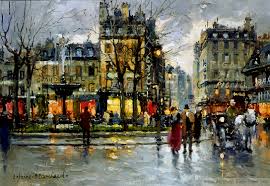Maurice Dekobra Finds the East in Pigalle
Posted: December 27th, 2014 | 4 Comments »A few weeks ago I blogged about the French writer Maurice Dekobra and his novel Macao: L’enfer du jeu. Dekobra was unknown to me until recently, but now, having read a bunch of his books I think of him as a sort of French version of Arnold Bennett with a bit of Somerset Maugham thrown in. Dekobra spent some time in China and around the Far East and wrote a number of books set in the East, though most of his work was set in his native France. However, traces of the East constantly appear in his French-set novels. Here’s a passage from his novel Midnight on the Place Pigalle (hard not like a writer who uses Midnight in his title!) published in 1932 and concerning a young man who has been thoroughly corrupted by being introduced to sex and the cabaret culture of Pigalle in Paris in the 1920s…
‘True, I have had a liaison with a little English dancer named Molly. She had a friend, and they insisted on my smoking opium. After Molly, I had an affaire with the wife of a banker who was addicted to flagellation. She initiated me by degrees in anima vili to the theories of Sacher Masoch…and the last month or so I tried cocaine with a literary lady, who consumed two dessertspoonfuls a week, and who handed me over to the tender care of a little Annamite, newly arrived from Saigon.’
Antoine Blanchard’s Place Pigalle


Glad to have come across this. Just reading Lu Xun’s èŠ±é‚Šæ–‡å¸ and heard about Dekobra for the first time. Lu rather took offense at Dekobra for allegedly portraying China in the same breath as “the natives of South Asia and South America.” Lu can only be as progressive in his leftist persuasions as his times permitted, distressing as his tone reads now. In an introduction to Dekobra Googlebook yielded up titled 浪蕩å美å¸èˆ‡è·¨æ–‡åŒ–ç¾ä»£æ€§ (The Dandy, the Flaneur, and the Translator – the English title is far less ostentatious than the Chinese academese), the author did Dekobra more credit. Dekobra apparently pushed the ideal Chinese beauty to free her shoulders and bosom from her stay, apply a tinge of blue to her slanted eye, and to stand at about five feet two. In a frequently seen act of cultural amnesia, the author from Taiwan, a woman, did not realize that “slanted eye” has a perfectly lovely Chinese rendition, 鳳眼, where the upswing of the eye corner is likened to the wings of the five-colored Chinese phoenix. Her transliteration of the term in Chinese becomes “wandering eye.” Translation is a risky business. I have not done better myself.
Thank you. I am off to reading your other posts on Dekobra.
Louisa – I think you are quite right – historically ‘slanted eye’ has been a difficult translation into English and of course now has racist connotations that further add to the problem – more romantic ‘almond shaped’ as well as more clinically accurate ‘double elipse’ type trasnlations etc don’t always feel right. I am hoping to read Peng Hsiao-Yen’s Dandy and Flaneur book but can’t really afford it (it is rather expensive) and my library doesn’t have it though I have requested it. I remain a fan of Dekobra, though recognise that I am, both my reading and own writing, a romantic nostalgist and so probably part of the problem!!
Oops, you’re right, the conundrum Peng faced in translating “slanted eye†did not occur to me. Translating it as “phoenix-eyed†would have veiled Dekobra’s orientalist word choice. Perhaps Peng could have adopted Eileen Chang’s ironic self-aware tone to tackle that problem? Say something along the lines of “一雙長斜了的æä»å½¢çœ¼ç›â€ï¼Ÿ(To emphasize that the “slanted†judgment assumes the Caucasian eye to be the norm.) Chang perfected the double vision of seeing China through foreign eyes, whose exploratory elation she then rendered suspect. “朱紅大柱,盤著é’ç¶ çš„é¾ï¼Œé»‘玻璃的牆,黑玻璃龕裡åè‘—å°é‡‘佛,外國è€å¤ªå¤ªçš„æ±æ–¹ï¼Œå…¨éƒ½åœ¨é€™è£¡äº†ã€‚â€With a deft turn she upsets the “Orient of old foreign ladies,†merely by repeating them.
I haven’t bought Peng’s book either. Google pulled up the title when I did a search on Dekobra. It let me browse 25 pages or so. I don’t call that a snippet, whatever Google’s lawyers may have said to stave off irate authors in court.
Let me hasten to add that I am all for romantic nostalgia. Faulting our predecessors for not embracing our cultural sensitivity, when it was often their groundbreaking insights that brought those sensitivities to fruition, strikes me as rather shabby. As you know, mainland China’s Republican-era fad has much nostalgia about it. Maybe Dekobra will be rediscovered?
(Incidentally, Eileen Chang borrowed some plot from one of Marquand’s books, and they had dinner once. She quite liked his writing, and thought him underrated. I see that you have him here too! 張愛玲的西方,您這兒也挺齊全。)
which Chang book borrows from Marquand and do you know the date they had dinner?